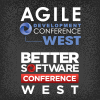Agile Development Conference & Better Software Conference West 2010

PRESENTATIONS
|
Story-o-types: The Patterns Within the Stories
Have you noticed that similar stories appear over and over again as you develop a system? According to Dan Rawsthorne, stories-those small chunks of work that make up your backlog and provide demonstrable value to the project-can be categorized by purpose: production, analysis, cleanup, infrastructure/environment, business support, or other. Within each of these categories are different “story-o-types”-patterns that define the commonalities among the stories themselves. |

Dan Rawsthorne, Danube Technologies |
|
Testing and Quality Beyond the Requirements and Code
Many organizations institute testing and quality improvement initiatives focused on testers, developers, and software managers. One stakeholder often ignored in these efforts is the user-your customer. To dramatically improve overall product quality, you must purposefully include the user in your testing efforts. Lanette Creamer illustrates this anecdotally with some important bugs missed, which would not be found even with 100% test and code coverage. |
|
|
Testing in an SOA Environment
Testing Web applications built with service-oriented architecture (SOA) is not the same as testing any other GUI-based application. Testing teams encounter major challenges including errors due to unexpected changes in internal and external services, compliance verification requirements, industry-specific standards, security issues, and more. To address these challenges, teams must adopt new testing methodologies that focus on ensuring the quality of services (QoS) deployed under the SOA development framework. |
|
|
Testing with Real Users--User Interaction and Beyond
Evidence shows than more than half of the ideas that we think will improve the user experience actually fail to do so-and some actually make it worse. Instead of guessing, why not measure what your real users like and don't like? Controlled, online experiments (A/B tests being the simplest version) are a proven way to make data-driven decisions about what works and what doesn't. Seth Eliot shares numerous examples of online experimentation within Microsoft to test new user interfaces with their customers. |

Seth Eliot, Microsoft |
|
The Art of Giving and Receiving--Feedback
When people work closely together, there's bound to be friction and irritation. Some people find it difficult to discuss these issues directly. So they hint and hope or simply procrastinate and don't do anything. Then, the irritation can grow out of proportion. Team members' ability to give peer-to-peer feedback-both about the work and the working relationship-is critical to developing a highly productive team. |

Esther Derby, Esther Derby Associates, Inc. |
|
The Battle of Scrum vs. Kanban
Over the past ten years, Scrum has become the leading project management approach in agile development. Now, there’s a new kid on the block-Kanban. Devotees of each approach emphasize their fundamental differences, debating pros and cons of one versus the other. Recognizing that their principles and practices are not utterly dissimilar, Jean Tabaka leads an open discussion about Scrum and Kanban approaches. For instance, both approaches create high project visibility and work in smaller increments than traditional development. |
|
|
The Joy of Legacy Code
Even though the code may have been written only five years ago, there it is-a sprawling unintelligible mess that nobody wants to touch. For most people and teams, this reality is a cause for fear and loathing-something we want to sweep under the rug. We can, however, choose to see “bad” code as a challenge to restructure and refactor into a maintainable design that serves the business for years to come. Although legacy code presents many constraints on design choices, it offers the opportunity for incremental improvement. |

Michael Feathers, Object Mentor |
|
The Power of Concept Designs in Requirements Elicitation
Ever been in a situation where everybody on the design and development team thinks they agree on the requirements-until you try to design that first screen or page? Wonder how exactly the same product requirements documentation can mean completely different things to different people? Ever heard users say of a new feature, “This is not what I expected or need”? To minimize the risks of these things happening again, join Scott Plewes and learn to create concept designs early in the project-during requirements elicitation. |
|
|
The Risk Management Paradox
The road to the financial ruin experienced on Wall Street during the past two years was paved with ineffective risk management strategies. While risk management theory continues to evolve, implementation of that theory often fails, especially when it comes to software. Though most executives readily acknowledge risk management is an essential practice for software projects, few can point to accomplishments and sustainability of their organization’s software risk efforts. |

Payson Hall, Catalysis Group |
|
Turning Conflict into Collaboration
One stakeholder says "Zig." Another says "Zag." There's no compromise in sight, and the project deadline looms closer. Between the rock and the hard place? Welcome to the real world of software development. We don't have to like conflict, but our ability to successfully deliver quality projects can depend on how well we navigate conflict. Andy Kaufman introduces you to conflict handling modes that describe different approaches to deal with conflict. |

Andy Kaufman, Institute for Leadership Excellence and Development, Inc. |


